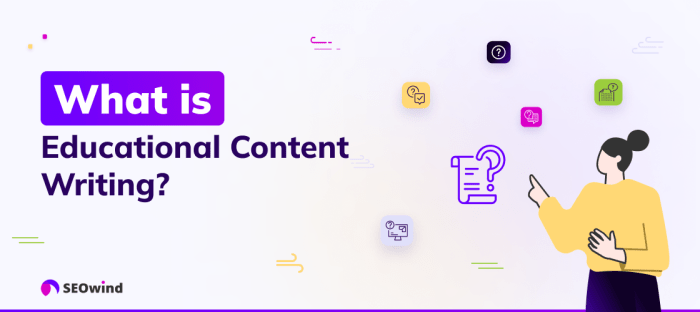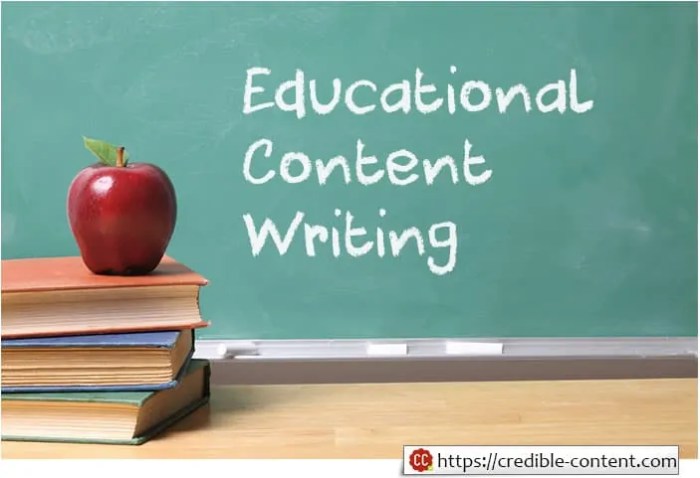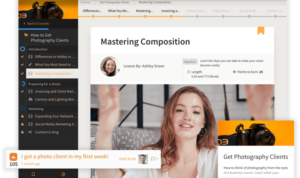Writing Educational Content sets the stage for creating dynamic and impactful learning resources, catering to diverse audiences and achieving educational objectives with finesse. Dive into the world of educational content creation with this comprehensive guide.
From understanding different formats to refining content and assessing its impact, this guide covers every aspect of crafting compelling educational materials.
Introduction to Writing Educational Content

When it comes to creating educational content, quality is key. High-quality educational content not only engages the audience but also provides valuable information and enhances learning outcomes.
The target audience for educational content can vary, but it typically includes students, teachers, parents, and anyone interested in learning or teaching a particular subject. Tailoring the content to the specific needs and interests of the audience is essential for effective communication and engagement.
The goals and objectives of educational content writing
Educational content aims to educate, inform, and inspire the audience. The main objectives of educational content writing include:
- Providing accurate and reliable information
- Promoting critical thinking and problem-solving skills
- Engaging the audience through interactive and multimedia elements
- Encouraging lifelong learning and continuous improvement
Understanding Educational Content Formats
When it comes to educational content, there are various formats that educators and content creators can utilize to effectively deliver information and engage learners. Each format has its own set of advantages and disadvantages, depending on the target audience and learning objectives.
Articles
- Advantages:
- Articles are versatile and can cover a wide range of topics in-depth.
- They are easily accessible and can be consumed at the learner’s own pace.
- Articles can include visuals, links, and references to enhance understanding.
- Disadvantages:
- Articles may require strong reading skills, which can be a barrier for some learners.
- They may not be as engaging or interactive compared to other formats.
- Articles may become outdated quickly in fast-changing fields.
Example: A blog post on “Top 10 Study Tips for High School Students.”
Videos
- Advantages:
- Videos are engaging and can cater to different learning styles.
- They can demonstrate complex concepts visually and audibly.
- Videos can be paused, rewound, and replayed for better comprehension.
- Disadvantages:
- Not all learners may have access to high-speed internet required for streaming videos.
- Creating high-quality videos can be time-consuming and resource-intensive.
- Content retention may vary among viewers depending on the video’s length and pacing.
Example: Khan Academy’s instructional videos on various math concepts.
Infographics
- Advantages:
- Infographics present information in a visually appealing and concise manner.
- They are easily shareable on social media platforms and can reach a wider audience.
- Infographics can simplify complex data and statistics for better understanding.
- Disadvantages:
- Creating effective infographics requires graphic design skills and software expertise.
- They may not be suitable for conveying detailed or lengthy information.
- Some learners may struggle with interpreting visual data compared to written content.
Example: An infographic illustrating the water cycle for elementary school students.
Research and Planning for Educational Content: Writing Educational Content
Research process involved in creating educational content is crucial for ensuring accuracy and relevance. This involves gathering information from reliable sources, such as academic journals, textbooks, and reputable websites. It’s important to verify the credibility of the sources to maintain the quality of the content.
Identifying Educational Needs of the Audience
To identify the educational needs of the audience, conducting surveys, interviews, and analyzing feedback are essential. Understanding the demographics, knowledge level, and learning preferences of the audience helps in tailoring the content to meet their specific needs. This ensures maximum engagement and comprehension.
Importance of Outlining and Planning Educational Content
Outlining and planning educational content before writing is crucial for maintaining a structured and organized approach. It helps in defining the objectives, deciding on the format, and establishing a logical flow of information. A well-thought-out Artikel serves as a roadmap for the content creation process, ensuring that all key points are covered effectively.
Writing Techniques for Educational Content
When it comes to writing educational content, it’s essential to engage your readers and keep them interested throughout. Here are some tips to help you do just that:
Engaging Readers
- Start with a compelling introduction to grab the reader’s attention from the beginning.
- Use storytelling techniques to make the content more relatable and engaging.
- Break up the text with subheadings, bullet points, and numbered lists to make it easier to read.
Simplifying Complex Topics
- Break down complex topics into smaller, more digestible chunks.
- Use analogies and real-life examples to explain difficult concepts in simple terms.
- Avoid jargon and technical language that may confuse readers.
Incorporating Visuals and Multimedia
- Use infographics, charts, and graphs to visually represent data and information.
- Include images and videos to enhance understanding and engagement.
- Make sure visuals are relevant and add value to the content, rather than just being decorative.
Editing and Refining Educational Content

After completing the initial writing phase, the next crucial step in creating high-quality educational content is editing and refining. This process involves reviewing the content for accuracy, clarity, and overall effectiveness to ensure it meets the intended educational goals.
Steps in Editing Educational Content
- Review for accuracy: Check all facts, statistics, and information included in the content to ensure they are correct and supported by reliable sources.
- Enhance clarity: Simplify complex ideas, rephrase unclear sentences, and remove unnecessary jargon to make the content more understandable for the target audience.
- Structure and organization: Ensure the content flows logically, with clear transitions between ideas and sections to enhance readability.
- Grammar and spelling: Check for grammatical errors, typos, and spelling mistakes to maintain professionalism and credibility.
- Consistency: Verify that formatting, tone, and style are consistent throughout the content to provide a cohesive learning experience.
Importance of Proofreading and Fact-Checking
Proofreading and fact-checking are essential aspects of editing educational content as they help maintain credibility and accuracy. Without proper proofreading, even the most well-researched content can be undermined by simple errors. Fact-checking ensures that the information presented is reliable and trustworthy, instilling confidence in the readers.
Common Mistakes to Avoid in Educational Content Writing
- Plagiarism: Always cite sources and avoid copying content without proper attribution.
- Ambiguity: Be clear and concise in your explanations to avoid confusion among readers.
- Overcomplication: Simplify complex concepts and avoid unnecessary technical language that may alienate the audience.
- Lack of structure: Ensure a logical flow of ideas and information to guide the reader through the content effectively.
- Ignoring feedback: Incorporate feedback from peers or educators to improve the quality of your educational content.
Assessing the Impact of Educational Content
When it comes to measuring the effectiveness of educational content, it’s essential to look at various factors to determine its impact on the audience. Gathering feedback and analyzing engagement metrics are key components in evaluating the success of educational materials.
Measuring Effectiveness
One way to measure the effectiveness of educational content is to track key performance indicators (KPIs) such as website traffic, time spent on page, click-through rates, and social media shares. These metrics can provide valuable insights into how engaging and informative the content is for the target audience.
Gathering Feedback
- Implement surveys or polls to collect direct feedback from the audience regarding the usefulness and clarity of the content.
- Encourage comments and discussions on the content to gauge interest and engagement levels.
- Utilize analytics tools to track user behavior and interactions with the content, identifying areas for improvement.
Analyzing Engagement Metrics, Writing Educational Content
- Look at click-through rates and conversion rates to assess how well the content is driving action and achieving its intended goals.
- Monitor bounce rates and time spent on page to understand if the content is holding the audience’s attention and providing value.
- Track social media metrics such as likes, shares, and comments to evaluate the reach and impact of the content.
Continuous Improvement Strategies
- Use feedback from surveys and analytics to make data-driven decisions on content revisions and updates.
- A/B test different versions of the content to see which performs better with the audience and optimize accordingly.
- Regularly review and refresh educational content to ensure it remains relevant and up-to-date with the latest information and trends.








